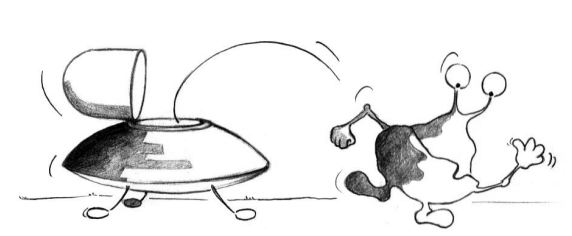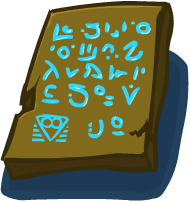


ICFP language
An Interstellar Communication Functional Program (ICFP) consists of a list of space-separated tokens. A token consists of one or more printable ASCII characters, from ASCII code 33 ('!') up to and including code 126 ('~'). In other words, there are 94 possible characters, and a token is a nonempty sequence of such characters.
The first character of a token is called the indicator, and determines the type of the token. The (possibly empty) remainder of the token is called body. The different token types are explained in the next subsections.
Booleans
indicator = T and an empty body represents the constant true, and indicator = F and an empty body represents the constant false.
Integers
indicator = I, requires a non-empty body.
The body is interpreted as a base-94 number, e.g. the digits are the 94 printable ASCII characters with the exclamation mark representing 0, double quotes 1, etc. For example, I/6 represent the number 1337.
Strings
indicator = S
The Cult of the Bound variable seems to use a system similar to ASCII to encode characters, but ordered slightly differently. Specifically, ASCII codes 33 to 126 from the body can be translated to human readable text by converting them according to the following order:
abcdefghijklmnopqrstuvwxyzABCDEFGHIJKLMNOPQRSTUVWXYZ0123456789!"#$%&'()*+,-./:;<=>?@[\]^_`|~<space><newline>
Here <space> denotes a single space character, and <newline> a single newline character. For example, SB%,,/}Q/2,$_ represents the string "Hello World!".
Unary operators
indicator = U, requires a body of exactly 1 character long, and should be followed by an ICFP which can be parsed from the tokens following it.
| Character | Meaning | Example |
|---|---|---|
- | Integer negation | U- I$ -> -3 |
! | Boolean not | U! T -> false |
# | string-to-int: interpret a string as a base-94 number | U# S4%34 -> 15818151 |
$ | int-to-string: inverse of the above | U$ I4%34 -> test |
The -> symbol in this table should be read as "will evaluate to", see Evaluation.
Binary operators
indicator = B, requires a body of exactly 1 character long, and should be followed by two ICFPs (let's call them x and y).
| Character | Meaning | Example |
|---|---|---|
+ | Integer addition | B+ I# I$ -> 5 |
- | Integer subtraction | B- I$ I# -> 1 |
* | Integer multiplication | B* I$ I# -> 6 |
/ | Integer division (truncated towards zero) | B/ U- I( I# -> -3 |
% | Integer modulo | B% U- I( I# -> -1 |
< | Integer comparison | B< I$ I# -> false |
> | Integer comparison | B> I$ I# -> true |
= | Equality comparison, works for int, bool and string | B= I$ I# -> false |
| | Boolean or | B| T F -> true |
& | Boolean and | B& T F -> false |
. | String concatenation | B. S4% S34 -> "test" |
T | Take first x chars of string y | BT I$ S4%34 -> "tes" |
D | Drop first x chars of string y | BD I$ S4%34 -> "t" |
$ | Apply term x to y (see Lambda abstractions) |
If
indicator = ? with an empty body, followed by three ICFPs: the first should evaluate to a boolean, if it's true then the second is evaluated for the result, else the third. For example:
? B> I# I$ S9%3 S./
evaluates to no.
Lambda abstractions
indicator = L is a lambda abstraction, where the body should be interpreted as a base-94 number in the same way as integers, which is the variable number, and it takes one ICFP as argument. indicator = v is a variable, with again a body being the base-94 variable number.
When the first argument of the binary application operator $ evaluates to a lambda abstraction, the second argument of the application is assigned to that variable. For example, the ICFP
B$ B$ L# L$ v# B. SB%,,/ S}Q/2,$_ IK
represents the program (e.g. in Haskell-style)
((\v2 -> \v3 -> v2) ("Hello" . " World!")) 42
which would evaluate to the string "Hello World!".
Evaluation
The most prevalent ICFP messaging software, Macroware Insight, evaluates ICFP messages using a call-by-name strategy. This means that the binary application operator is non-strict; the second argument is substituted in the place of the binding variable (using capture-avoiding substitution). If an argument is not used in the body of the lambda abstraction, such as v3 in the above example, it is never evaluated. When a variable is used several times, the expression is evaluated multiple times.
For example, evaluation would take the following steps:
B$ L# B$ L" B+ v" v" B* I$ I# v8
B$ L" B+ v" v" B* I$ I#
B+ B* I$ I# B* I$ I#
B+ I' B* I$ I#
B+ I' I'
I-
Limits
As communication with Earth is complicated, the Cult seems to have put some restrictions on their Macroware Insight software. Specifically, message processing is aborted when exceeding 10_000_000 beta reductions. Built-in operators are strict (except for B$, of course) and do not count towards the limit of beta reductions. Contestants' messages therefore must stay within these limits.
For example, the following term, which evaluates to 16, uses 109 beta reductions during evaluation:
B$ B$ L" B$ L# B$ v" B$ v# v# L# B$ v" B$ v# v# L" L# ? B= v# I! I" B$ L$ B+ B$ v" v$ B$ v" v$ B- v# I" I%
Researchers expect that the limit on the amount beta reductions is the only limit that contestants may run into, but there seem to also be some (unknown) limits on memory usage and total runtime.
Unknown operators
The above set of language constructs are all that researchers have discovered, and it is conjectured that the Cult will never use anything else in their communication towards Earth. However, it is unknown whether more language constructs exist.